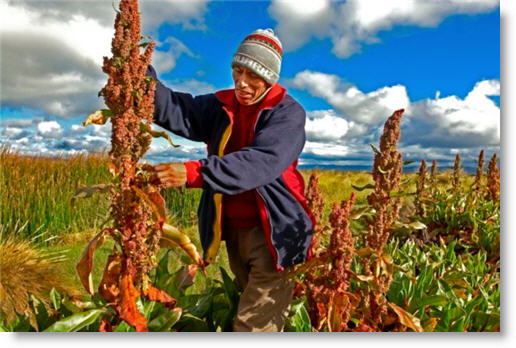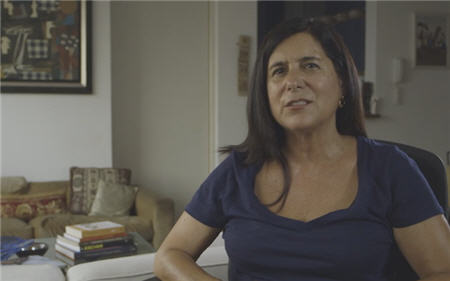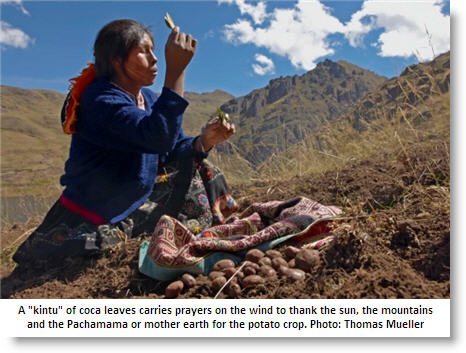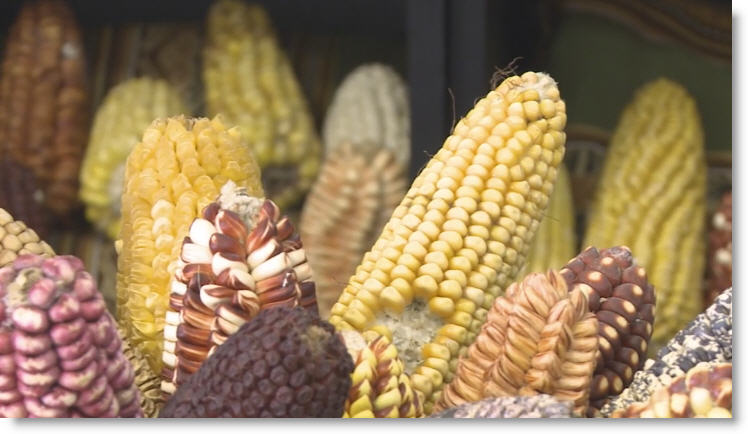
Delia Ackerman has set herself a challenge. The award-winning filmmaker is going beyond Peru’s gastronomic boom to highlight and revalue the traditional knowledge and amazing nutritional value of the “super foods” farmed for hundreds, even thousands of years in the Andes. Some of these foods are now famous, but there are still others that not only warrant recognition but need protection.
“Hatun Phajcha, The Healing Land” is her newest documentary film, a work in progress. Several years of research are near completion and Ackerman is now turning to crowd funding through Indiegogo to finance the first part of the recording and shooting of the film.
The film will take the audience through the culturally and biologically diverse regions of Peru to highlight the remarkable health benefits and nutritional value of foods that are often unknown or overlooked. Viewers will meet hardworking farmers, committed “guardians” of many species, dedicated scientists, creative chefs and nutritionists, and enthusiastic entrepreneurs who want to build on the successes of other Peruvian products.
 Hatun Phajcha looks beyond the food trends, however.
Hatun Phajcha looks beyond the food trends, however.
“There has been an explosion of interest in Peruvian native foods and gastronomy, which is attracting people from all over the world. Yet, paradoxically, many Peruvians —as others across the world— suffer high levels of anemia and malnutrition,” Ackerman says.
Despite the wealth of nutritious plants, there is still a high percentage of malnutrition in Peru and a growing danger of obesity. The chronic malnutrition rate is around 19% nationwide for children under the age of five, and in rural areas it can be as high as 33%.
“We want to help people rediscover the value of underutilized Peruvian crops that could help alleviate many nutritional deficiencies in Peru, and elsewhere as well.”
Over the centuries, Peru’s farmers have stored a virtual treasure house of nutritional wealth, cultivating and propagating Andean crops rich in nutrients. Some of these foods — from the land that gave the potato to the world — are well-known, such as the protein-packed quinoa, which NASA uses to feed its astronauts and has now become fashionable worldwide. But there are so many others that are either not even known in Peru’s main cities or whose nutritional value has been forgotten by even rural populations —these include aracacha, aguaje, mashua and pitjaya.
Each of this seemingly endless variety of grains, tubers and fruits has inordinate nutritional and healing values.
“Peru is a natural pharmacy,” says nutritionist Talia Schvartzman, an advisor to the film project,
 Ackerman wants to make sure we don’t lose this knowledge nor the farming traditions that have protected these foods over the centuries, while at the same time increasing production to meet nutritional needs.
Ackerman wants to make sure we don’t lose this knowledge nor the farming traditions that have protected these foods over the centuries, while at the same time increasing production to meet nutritional needs.
One example that Ackerman gives of the spirit of conservation that runs through traditional farming is a festivity held in June in different parts of Peru to exchange seeds. She travelled to Huanuco for the Muru Raymi, literally the Feast of Seeds in Quechua, a genuine feast of agro-biodiversity for producers of tubers, roots, grains and fruits. As generations before them, farmers from communities living at different altitudes in Huanuco gather in the main square of Huancapallac to exchange their best seeds, thus ensuring continuing biodiversity and food security. A ritual of dance and music is an essential part of the fiesta, as hands exchange products of multiple shapes, colors, flavors and benefits.
“You could say that just as the seed banks of Svalbard in Norway and the gene banks in Peru, the Muru Raymi would be the way that Andean Peru keeps alive its agro-diversity.
Born and raised in Peru, Ackerman has a Master’s degree from Columbia University’s School of Journalism and has produced several documentary films on conservation and healing.
“I am Jewish, and also a Buddhist, a “Jubu,” says Ackerman. “I have a wonderful mother who passed on to me the great pleasure of nurturing and feeding others…..and I am privileged to be the citizen of a country that has so much to offer . I feel compelled to share some of its abundance through the film.”
 Malnutrition
Malnutrition
“So much of Peru’s ancient knowledge has been devalued and lost since the colonization of the country that, even in Peru, nutritious crops are often not valued and many children grow up seriously undernourished,” Ackerman says.
“In other parts of the world the situation is even worse. According to data from UNICEF, the World Health Organization (WHO) and FAO, half the people on the planet today are malnourished. Every year, an estimated 3.1 million children under the age of five die, and 161 million are irreversibly stunted physically and mentally because of chronic malnutrition.
“Our global food system is overburdened and many fear it will become even more so with the impact of climate change and rapid population growth. It is time to take advantage of the potential to be found in lesser known foods that have high concentrations of nutrients. These super foods or power foods can have an important impact once they become better known and more available.”
Through the film, Ackerman aims to generate not only support to farmers and scientists but to influence policy makers on the importance of safeguarding and developing thee native foods as a national resource.
“Making healthier food options available to every kitchen and raising awareness among policy makers can help reverse some of the most serious global health problems,” Ackerman believes.
To contribute to Delia Ackerman’s film project, visit the Indiegogo campaign and also sign up to receive updates on the film, tantalizing tidbits about research into Peruvian “superfoods,” and introductions to the people who bring them to tables around the world. Although the campaign itself ends August 24, the Indiegogo page will remain open and continue to accept funds until the film’s production is complete. Contributors can choose special Perks in return for their support.






Great article; important topic!
Thank you PERUVIAN TIMES for sharing my project and writing this beautiful articule.
And here again for those who want to be part of the project here is the link: https:// www. indiegogo. com/projects/the-healing-land–4
And even after the campaign ends you can still contribute. Here is my email address: pachacamacdelia @gmail. com
Maravilloso documental de los productos nutraceuticos que abundan en nuestro fabuloso país pero que, muchos, han quedado en el olvido.